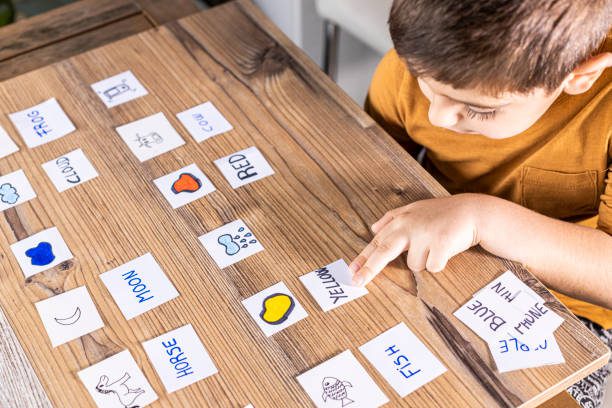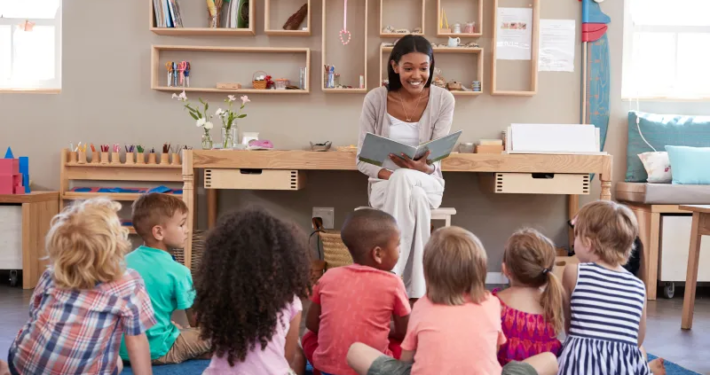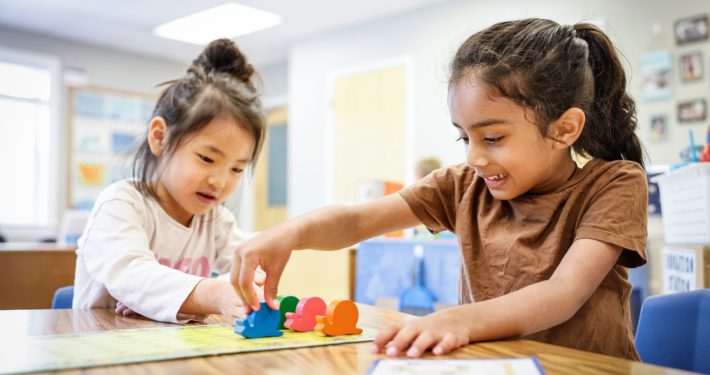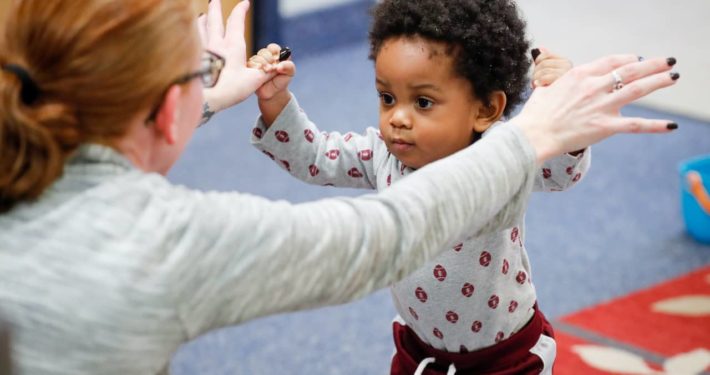Literacy in early childhood is not only about letters and words. It begins long before children learn to read and grows through conversation, storytelling, listening, drawing, dramatic play, and exposure to books. When preschoolers express ideas, retell stories, sing rhymes, notice letters, and talk about their experiences, they are building the foundation for confident future readers and communicators.
These playful experiences make language meaningful in everyday life and help children develop vocabulary, listening comprehension, sequencing, early phonics awareness, and confidence in self-expression.
Below are simple literacy and language activities that turn daily moments into rich learning opportunities.
All About Me Book
This keepsake book lets children celebrate who they are by sharing their favorite things, family members, dreams, and personality. It encourages vocabulary and self-expression while helping children understand that books can tell their own unique story.
Steps
- Create pages reflecting different themes (family, favorites, hobbies, feelings).
- Invite your child to draw or add photos to each page.
- Ask questions to spark language (What do you like? Who do you love? What makes you happy?).
- Read the finished book together and celebrate their individuality.
Age-Appropriate Adaptations
- Two-year-olds — Color pages with support and add family photos.
- Three-year-olds — Select topics for each page and label favorite things.
- Four-/Five-year-olds — Generate sentences to accompany illustrations.
Skills Supported
Book awareness, vocabulary, self-identity, fine motor development
Read-Aloud & Illustration Activity
Drawing after story time encourages deep listening and comprehension as children transform what they heard into visual memory. Using artwork to retell the story strengthens vocabulary, sequencing, and expressive language.
Steps
- Read a story aloud.
- Invite your child to pick a part of the story to draw.
- Support them in labeling characters, events, or places.
- Ask them to explain their drawing and retell the story in their own words.
Age-Appropriate Adaptations
- Two-year-olds — Draw one part of the story (a character, event, favorite page).
- Three-year-olds — Retell the story using the drawing as a visual reference.
- Four-/Five-year-olds — Sequence the story beginning–middle–end in illustrations.
Skills Supported
Listening comprehension, story recall, sequencing, vocabulary development
Storytelling Activity: Storytime and Me
This activity turns children into storytellers. When an adult writes a child’s spoken story and the child illustrates it, they learn that their words have power and can become a written book others can read.
Steps
- Invite your child to tell an imaginative story.
- Write their words down exactly as spoken.
- Create pages and let your child illustrate each part of the story.
- Read the completed story together and display it proudly.
Age-Appropriate Adaptations
- Two-year-olds — Tell a simple story using pictures or stuffed animals.
- Three-year-olds — Add multiple characters and details about setting.
- Four-/Five-year-olds — Create a full story arc with a beginning, middle, and end.
Skills Supported
Oral storytelling, expressive language, sequencing, comprehension, creativity
Sound It Out
Exploring letter sounds helps children make the powerful connection between written letters and spoken language. Playful phonics activities make early reading feel natural and enjoyable.
Steps
- Sing or listen to songs that highlight letter sounds.
- Match letters to objects that begin with the same sound.
- Say each sound slowly and invite children to blend it into a word.
- Encourage experimenting with new sounds, not perfection.
Age-Appropriate Adaptations
- Two-year-olds — Sing alphabet songs and identify the first letter of their name.
- Three-year-olds — Practice letter sounds using objects that start with the same sound.
- Four-/Five-year-olds — Build simple CVC (consonant-vowel-consonant) words by segmenting and blending sounds.
Skills Supported
Phonemic awareness, letter-sound correspondence, vocabulary, early spelling
Messy Spelling Activity: Shaving Cream Spelling
This sensory-rich literacy activity turns early writing into play. Forming letters and simple words in shaving cream builds hand strength and confidence while making spelling fun and pressure-free.
Steps
- Spread shaving cream across a table or tray.
- Use fingers to form letters or short words.
- Say each letter or word aloud while writing.
- Smooth the foam and start again for repeated practice.
Age-Appropriate Adaptations
- Two-year-olds — Form the first letter of their name using a model.
- Three-year-olds — Write all letters of their first name independently using a model to reference.
- Four-/Five-year-olds — Spell first and last name independently and write simple words.
Skills Supported
Fine motor strength, vocabulary development, handwriting preparation, sensory processing
Looking for more activities?
There is so much more to explore. Children learn best when they can move, build, create, experiment, and express themselves across every developmental area.
→ Explore more activities and learning tools for kids.
Why Early Literacy Matters for Toddlers, Preschoolers, and Pre K Learners
Early literacy lays the foundation for school readiness and lifelong learning. Long before children learn to read, they develop literacy through conversation, storytelling, listening, singing, dramatic play, drawing, and exposure to books. When young children express ideas, retell stories, listen to read-alouds, and talk about their experiences, they build the skills needed to become confident readers and communicators.
• Early literacy builds vocabulary and expressive language.
Children who are regularly engaged in rich conversations and exposure to language develop stronger vocabulary and language skills in preschool and beyond (NAEYC).
• Storytelling and read-aloud experiences strengthen comprehension and sequencing.
Listening to and retelling stories helps children organize information, recall events, understand cause and effect, and make meaning from text (Reading Rockets).
• Phonological and letter sound awareness support future reading development.
Playful exposure to rhymes, songs, letter sounds, and sound blending builds the decoding foundation needed for learning to read (National Institute for Literacy).
• Early literacy supports confidence, communication, and school readiness.
Children who have positive early literacy experiences feel more comfortable expressing ideas, asking questions, solving problems, and engaging in learning and social interactions (CDC).
How Can Families Incorporate Literacy Activities In Everyday Life?
Families do not need flashcards or worksheets to support early literacy. Young children develop strong language and reading foundations through everyday interactions that feel warm, natural, and connected. Talking during daily routines, sharing stories at bedtime, noticing print on signs, singing songs in the car, and drawing together all build literacy skills in ways that feel fun.
When these experiences are consistent, children become confident communicators. They learn to express ideas, remember story events, ask questions, sequence information, and explore the sounds and shapes of language. These habits prepare children not only for reading, but also for self advocacy, social connection, and academic success.
With simple daily routines, families can help children build:
✔ vocabulary and language skills
✔ listening comprehension and story recall
✔ sequencing and memory
✔ phonemic and letter sound awareness
✔ confidence in communication and self expression
Every playful moment that involves speaking, listening, storytelling, drawing, singing, reading, or noticing print supports a growing reader.
Daily Literacy and Language Rich Learning with Cadence Education
Language and literacy come to life every day at Cadence Education. Our classrooms invite children to talk, listen, read, write, act out stories, share ideas, and explore books so they develop the confidence and curiosity that create lifelong learners. We support early literacy through warm relationships, rich conversations, and playful experiences because children learn best when language feels meaningful and joyful.
We would love to meet your family and learn more about your child’s interests, strengths, and learning style.





